Best Free Fm Radio App Tuner on Google Play
Let's be honest: FM radio is not what it used to be. Of all the music, news, commentary, and other audio content available in the world, the FM dial only captures a tiny–and bland–percentage of it. If this wasn't obvious before, it's been made clear by the advent of podcasting and the explosion of smart, personalized audio apps available on computers, phones, and tablets. Why tune in to a commercial-packed parade of the same top 40 hits when you can listen to music based on your own tastes? Why bother with whoever happens to be rambling on talk radio right this very moment, when your favorite host is a tap away? The Internet is far better at delivering audio to people than radio waves are.
So why does FM radio persist? For one, it still makes money. It's also built into just about every car on the road. And as magical as the Internet is, FM radio waves are still more ubiquitous and reliable (you never hear about the radio going down).
But web-based music technology is improving quickly and everyone knows it's giving FM a run for its money. We have 4G mobile devices and new cars with audio apps built into the dashboard. A simple Bluetooth connection can paste your playback UI of choice from the tiny screen to the dashboard or the controls on the steering wheel.
Since cars are such a mainstay of FM radio, bridging the user experience gap between phones and automobiles is going to be a crucial part of overhauling what we today know as "radio." It'll be a while before FM is rendered unrecognizable, but a handful of today's most innovative players seem especially well-positioned to help forge that future. Here they are.
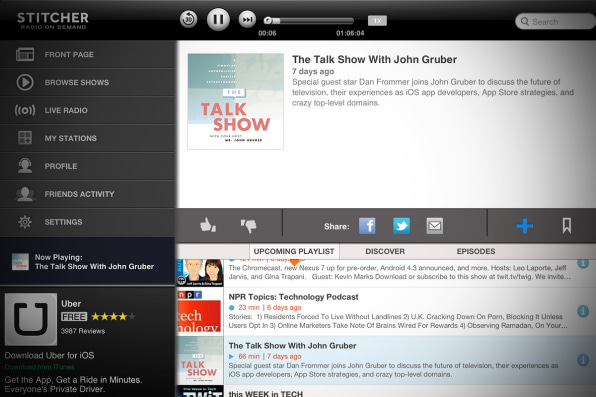
Stitcher Radio
What most makes Stitcher Radio feel like a viable replacement for the FM dial isn't the app's personalized radio stations. Nor is it the smart discovery features built in throughout the interface. Those things are great, but what makes it feel like radio is something far simpler: The audio is infinite.
Once you load Stitcher with the podcasts and non-commercial FM streams of your choice, it starts to learn what you love. You can build out "stations" of programs (I have stations for tech, world news, and music commentary, for instance). As you listen and tap the Pandora-style thumbs up/down buttons, it gets even smarter. Using this knowledge, it builds out a customized station of recommended programs, fueling the discovery of new audio shows.
Most crucially of all, listening to Stitcher is a "lean back" experience. When one program or segment is finished, it jumps to the next one automatically. This simple feature (along with the FM streams) is what sets it apart from other podcasting apps. It's also what saves you from careening to your tragic and untimely demise while you're listening in the car. It even has a "Car Mode" to simplify the controls should you need to access them.
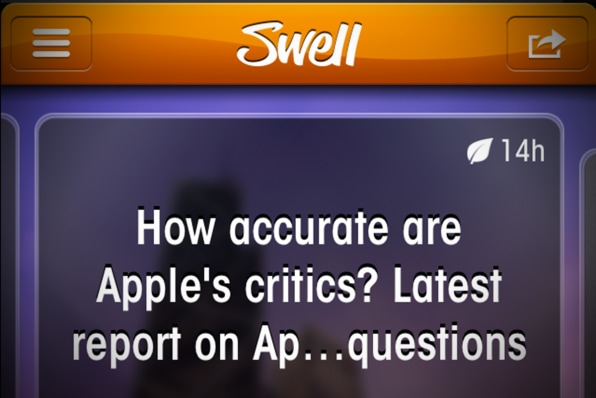
Swell
One of the biggest obstacles apps face in their quest to replace FM radio is their own interfaces. In order to compete with radio, apps need to be pleasant and safe to use while driving. In the car, more so than any other context, simplicity is key.
Swell takes this mantra to an extreme, stripping out much of the functionality one expects to see in a mobile audio app and giving the user very little opportunity to stare down at a screen and make decisions. Billing itself as a sort of "Pandora for news," Swell lets users select broad topic areas like "technology" or "music" and then auto-generates a playlist of public radio and podcast audio content that cycles through itself without user intervention. The only audio controls the user has are to listen, pause, swipe to skip, or jump 30 seconds forward or backward. Over time, Swell learns what you like and hones its playlists accordingly. Think Stitcher, but more serendipitous.
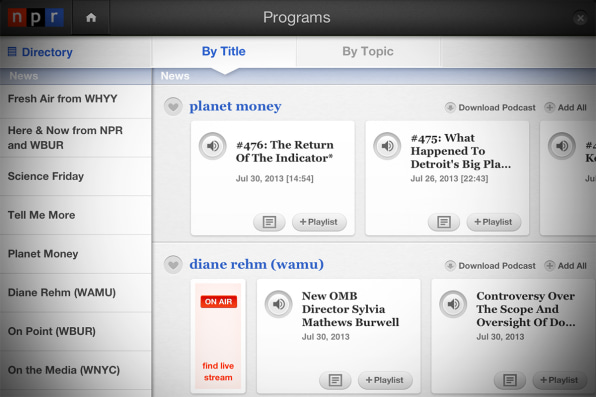
NPR
You don't have to be a VC-funded tech startup to master mobile digital radio. The folks at NPR have long been forward-thinking about new platforms and technologies, and the smartphone revolution did not catch them off guard. The organization's mobile apps sport the perfect blend between live public radio streams and on-demand NPR shows. This combo single-handedly eliminates the need to touch the FM dial to hear what's on now, while simultaneously serving up an archive of your favorite shows on demand. The app's playlist builder encourages hands-free, lean-back playback wherever the user may be.
It's not just about phones and tablets, though. NPR's digital team has been very proactive about ensuring the organization's content is available on as many platforms as possible. That, of course, means offering a variety of apps for iOS, Android, and other prominent mobile platforms. But it also means integrations with smart TV platforms and, most importantly, teaming up with car manufacturers. Old media, my eye.
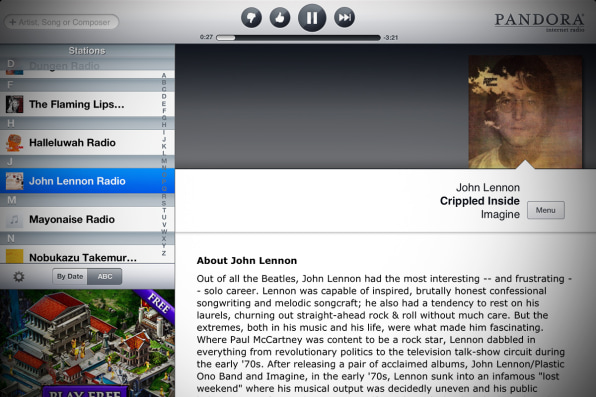
Pandora
The notion that Pandora could disrupt terrestrial radio isn't exactly a new one. On the surface, it's almost too obvious to mention. But Pandora's position at the forefront of Internet radio should not be taken for granted. The company faces fierce competition from huge players like Google and Apple and its struggle to reduce onerous music licensing costs has won it more bad press than progress.
Still, Pandora has two huge advantages. For one, its music recommendation and playlist generation technology–fueled both by machines and the human expertise of trained musicians–is still superior to that of its competitors. Some are gaining ground, but there's still something to be said for hiring real-life musicians to feed the algorithms (and eight solid years of data generated by millions of listeners doesn't hurt either). Pandora's other key asset is its strategic focus on cross-platform availability. The company is partnering with more and more car manufacturers to ensure that its smart music discovery engine is effortlessly available where most people do their radio listening.
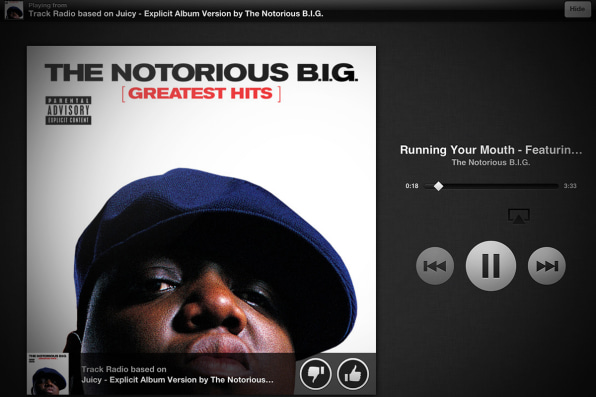
Spotify
The obvious one: Spotify. At its core, it's not an Internet radio service. But the preeminent all-you-can-stream music subscription service has bolted on its own Pandora-like radio product of its own and its new "Discover" tab is very, very good at surfacing music you either already love or are bound to enjoy. Crucially, both features are available on Spotify's mobile apps, which makes them a Bluetooth connection or audio cable away from supplanting whatever top 40 fluff is blaring through the fuzz of FM.
By combining on-demand music with Pandora-style Internet radio, Spotify offers the best of both worlds. You can curate your own listening experience like an iPod with unlimited capacity or you can let the algorithms pick songs for you. In this case, that automated curation is powered by the Echo Nest, a music intelligence engine that deserves a nod of its own. The service also fuels Rdio's radio feature, iHeartRadio, and a long list of Internet radio apps out there.
What gives Spotify the radio crown is its combination of personalized stations, top-notch curated discovery, and on-demand streaming of albums and songs galore. Spotify's radio and playlists make for a more hands-free, and thus safer experience for drivers. With the liberty to browse your favorite subset of Spotify's 20 million songs (not to mention your own library, which you can sync with Spotify's mobile apps), there's even less of a reason to tune in to the commercially motivated whims of some deejay.
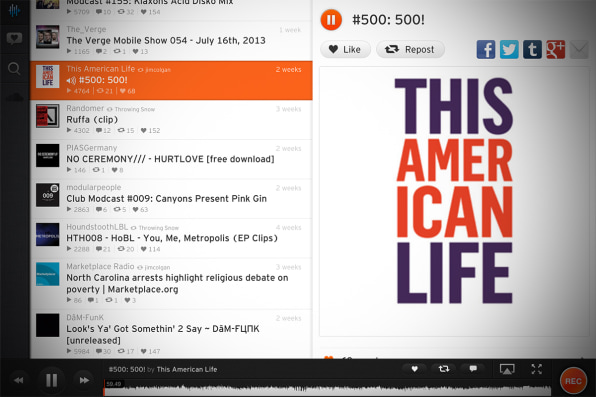
SoundCloud
One doesn't usually associate SoundCloud with Internet radio. Unlike the likes of Spotify, iTunes, and Google Play, SoundCloud doesn't even have a feature with "radio" in its name. They're not trying to compete with Pandora. But in its quest to become the YouTube of audio, the growing social audio service is unwittingly building out an experience that could soon rival radio.
SoundCloud started as a repository for bedroom demos, fan-made remixes, and tracks from independent artists. It has since blossomed into something utilized by labels big and small and that established artists use to float new material. The amount of music available on SoundCloud (much of which is absent from Spotify and other streaming services) is staggering. To top it all off, the Berlin-headquartered company has been actively courting podcasters, public radio outlets, and known radio personalities, encouraging them to use SoundCloud as a supplementary publishing platform. The result is a hyper-varied selection of audio content that makes terrestrial stations feel staler than ever.

Shuffler.fm
It doesn't get anywhere near as much attention as these other apps, but Shuffler.fm deserves a nod for its crack at music curation. Rather than relying on algorithms or even its own team of music experts, the service turns prominent music bloggers collectively into deejays. The service mines some of the hottest music blogs, crawls them for audio and video and aggregates it all by genre, effectively creating crowd-curated radio stations and turning the modern variety of music tastemakers–bloggers, that is–into something more analogous to disc jockeys of yesteryear. But there's a twist: Instead of playlists generated by the traditional methods of radio programming, with a crowdsourced, blogosphere-fueled twist.
Touting itself as a "Flipboard for music," the iOS app and its browser-based counterpart do an excellent job of digging up the gems making the rounds on more under-the-radar music blogs. And the genres go beyond the broad and expected. If terms like "shoegaze," "chillwave," and "future garage" mean anything to you, you'll appreciate what Shuffler.fm is doing.
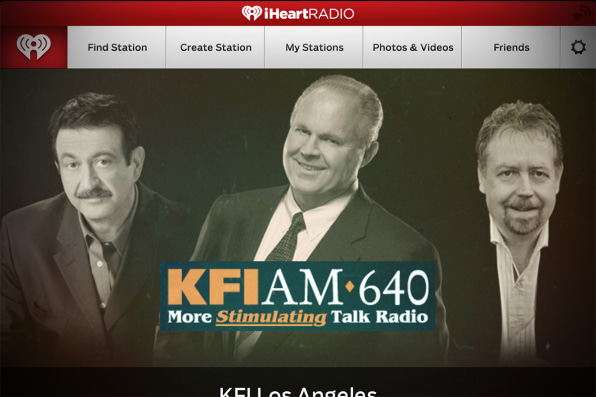
iHeartRadio
For all the wonder of algorithms and APIs, there's still something to be said for the old-fashioned way of curating music, if it's done right. If the future features a hybrid of the old and new, then Clear Channel's iHeartRadio will undoubtedly play a central role in forging it.
On the surface, iHeartRadio feels more like a defensive reaction than a bold act of innovation. But by merging terrestrial FM streams with Echo Nest-powered, personalized Internet radio stations, the delightfully cross-platform app stakes out the middle ground between what was and what's next. You've got to give Clear Channel credit. This is more forward-thinking than anything the newspaper industry tried when it was poised to be gutted by technological change. Sometimes, rather than waiting around, it makes more sense to try and disrupt yourself.
Best Free Fm Radio App Tuner on Google Play
Source: https://www.fastcompany.com/3015141/the-8-music-apps-that-will-slowly-destroy-fm-radio

0 Response to "Best Free Fm Radio App Tuner on Google Play"
Post a Comment